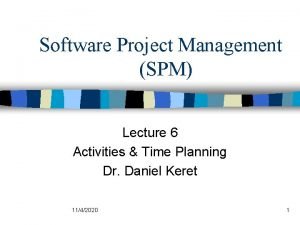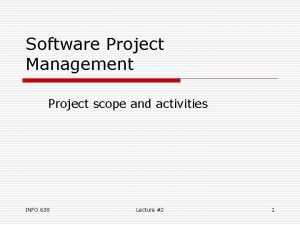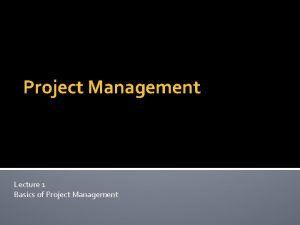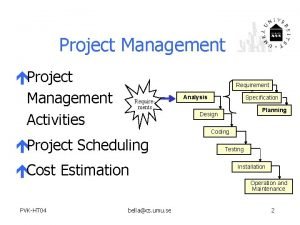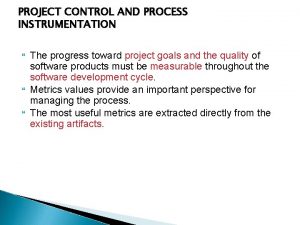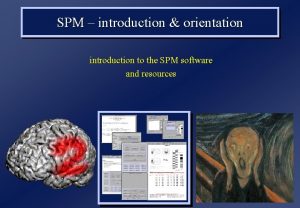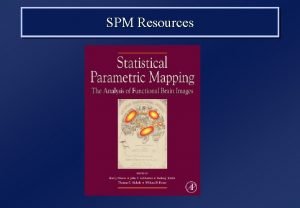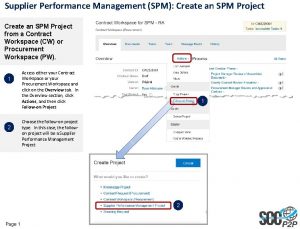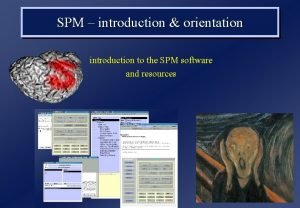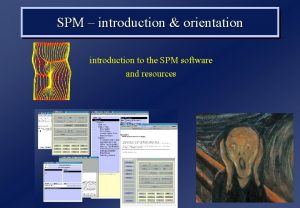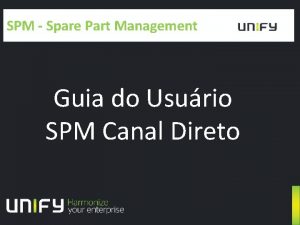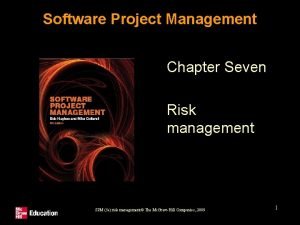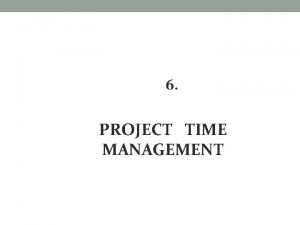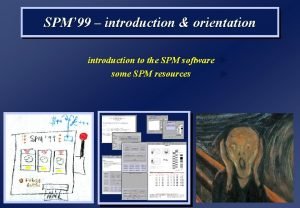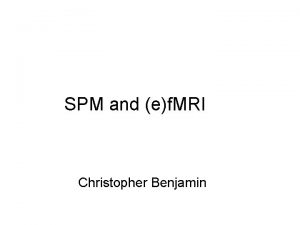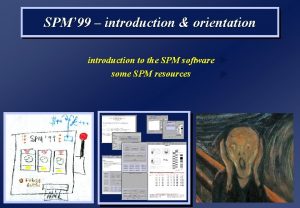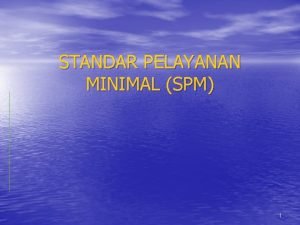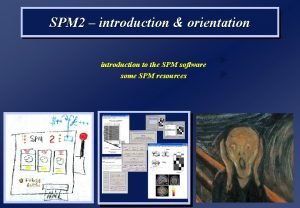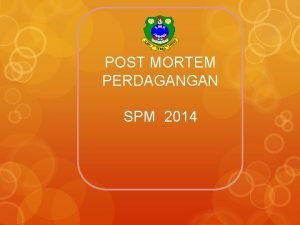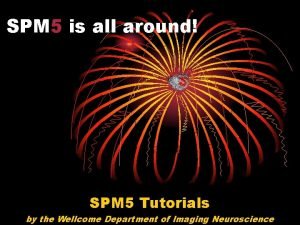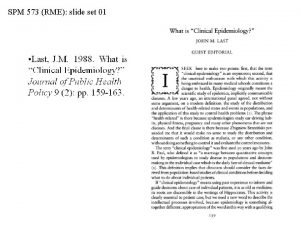Software Project Management SPM Lecture 6 Activities Time




















- Slides: 20

Software Project Management (SPM) Lecture 6 Activities & Time Planning Dr. Daniel Keret 11/4/2020 1

Reading Assignment Software Project Management, Bob Hughes and Mike Cotterell, Mc. Graw-Hill, 3 rd Edition. • Chapter 6 A Guide to the Project Management Body of Knowledge, PMI Publications, 3 rd Edition, 2004 • Chapter 6 11/4/2020 2

Activities & Time Planning n n n Breakdown WBS to Activities and Tasks Activities Sequencing Activity Resource Estimating Activity Duration Estimation. Scheduling of Work – Network Analysis of Scheduling – CPM & Interdependencies Charts (Critical Path, Fast Tracking & Crashing) n Schedule Control 11/4/2020 3

Breakdown WBS to Activities and Tasks n Activity – Element of Work Perform During the Course of a Project. It has: – – – Expected Duration Expected Cost Expected Resource Requirement Activities Can be Further Divided Into Tasks Task: A Task Effort Is What A Professional Employee Should Know and is NOT Detailed in the Work Plan The Activities Milestones are Derived from the WBS n Examples: Define Interface Requirement, Design Interfaces, Create Test Data n 11/4/2020 4

n n n Defining an Activity Break a WBS Task to a Smaller (time, effort, resource wise) Controllable Activities. Use Templates of Activities From Previous Projects and Adopt Professional Organizations (ISO, IEEE) Templates Rolling Wave: Activity that is Planned For Execution in the Near Term Should be Very Detailed. Others can be Kept in an High level Form. Use Expert Judgment Planning Component: When there is not enough data to generate WBS Item, an higher level WBS can be a basis for high level project schedule. Each Activity is Assigned with the Resources it Needs in order to be Completed (Time, Cost, manpower, etc. ) 11/4/2020 5

Activity Resource Estimating Identify needed Resourced (Manpower, Equipment, H/W, Etc) n Identify Quantity of Each Resource n Verify Resource Availability to Perform The Activity n Resource Breakdown Structure (RBS) n – Hierarchical Structure by Resource Category and Type ( Programmer, Analyst. Employee, Contractor) n Techniques Used for Estimation – Expert Judgment – Published Estimating Data – Project Management Software ( For Resource Breakdown Structure, Resource Availability and Resource Rates Purposes) 11/4/2020 6

Activities Duration Estimation The Duration Estimation Is a Progressive Task. The More Accurate the Activity is Defined a Better Estimate is Evaluated. n Techniques Used For Estimation n – – Expert Judgment Analogous Estimation (Similar Activity, Historical Information) Parametric Estimation (Function Point, Etc) Three Point Estimation: Most Likely, Optimistic, Pessimistic ( Average of the 3 can be a good baseline) – Reserve (Contingency, Risk, Etc) n Duration Estimation Example: – 2 Weeks +/- 2 days (8 -12 Days) – 15% probability of Exceeding 3 Weeks 11/4/2020 7

Activities Sequencing Identify and Document the Logical Relationships among Scheduled Activities. n The Activities Will Be Sequenced According to: n – Precedence Relationships – Leads To Support Later Development – Project Schedules and Milestones n Based on: – – Project Scope Statement Activity List Milestone List Approved Change Requests 11/4/2020 8

Precedence Diagram Method Activities Are Nodes (AON – Activities On Node) n 4 Types of Precedence Relationships (Arrows) n – – n Finish To Start Finish To Finish Start To Finish Dependency Determination – Mandatory (Hard Logic) – Discretionary (Preferred Logic, Best Practice) – External Dependency (Project – Non Project Relationship, Legal Constrains, Supplies Delivery Deadlines, Etc) Loops are NOT Allowed n Dangles (Dead Ends) Are NOT Allowed n Lagged Activities are shown on the arrows ( Documentation starts 2 days after Test Start Dates) n Hammock Activity – Has Zero Time. Represents Resources such as Overheads with Constant Cost Over the Duration of a Set of Activities n 11/4/2020 9

Test Plan 11/4/2020 10

Activity Labeling Convention For Sequencing Purposes n n n n Activity Label Activity Description Earliest Start Earliest Finish Latest Start Latest Finish Activity Span (Duration Between Earliest Start and Latest Finish – Maximum Time Allowed) Float (Duration Between Earliest Start and Latest Start. Zero Span Indicates Critical Activity. Any Delay Will Impact the Finish Date Of the Project) 11/4/2020 11

Critical Path Method - CPM The Forward Pass – Identify the Earliest Date an Activity Can Start n The Backward Pass – The Latest Date an Activity Can Start Without Delaying The End Date Of The Project. n The Critical Pass – Calculate the Float Time. The Critical Pass are the Activities with Zero Float Time. n – The Activities on the Critical Path should be paid a special Attention as Any Delay in these activities will Postpone The Project Completion Date – Any wish to Shorten the Project Schedule Should Deal With The Critical Path Activities 11/4/2020 12

3 11/4/2020 13

3 11/4/2020 14

3 0 11/4/2020 0 15

Schedule Compression n Crashing – Analyzing Schedule Compression with MINIMAL Cost Increase n Fast Tracking – Activities Which are Schedule to Perform in Sequence (Discretionary) will Perform in Parallel, This Will Add RISK to the Project 11/4/2020 16

Apply Calendars n Project Calendar: ASSIGN ACTUAL DATES TO THE PROJECT SCHEDULE – Adjust Holidays and others “Vacation Days” n Resources Calendar – Non Availability of Resources On Certain Dates – Trainings Dates, – Working Hours Information (Part Time Employee) n Resource Leveling – Shared or Critical resources May be Limited or not Available in Certain Time. – The Project Management May Wish to Keep Some Resources at a Reasonable Stable Level. – These Will Require Adjustments to the Project Schedule n Generate Project Schedule Baseline for approval and tracking of the actual performance 11/4/2020 17

Schedule Control n Reports the Current status of the project schedule n Detects the factors that create schedule change n Determine that the project schedule has changed n Manages the actual change as it occurs 11/4/2020 18

Schedule Control Tools and Techniques n Progress Report – Current Schedule Status – Actual start and finish dates – Remaining duration for unfinished schedule activities n Schedule change control system – Paperwork, tracking system and approval levels for the schedule change procedure n Performance Measurements – Schedule Performance Index (SPI), Schedule Variance (SV) – Project Management Software – Variance Analysis: Compare Target schedule dates with actual/forecast ones. Used for deviation detection and correction activities (Example: A major delay in non critical path activity may have a small impact) – Schedule comparison bar chart 11/4/2020 19

Schedule Control Outputs n Schedule Model Updates – Modifications to the project schedule model – Notification of appropriate changes to the stakeholders – New project schedule network diagram is developed n n n Schedule Baseline Update ( As a result of approved change requests) Performance measurements Requested changes Recommended corrective actions Lessons learned documentation – updates Updates of relevant project’s sub planes 11/4/2020 20
 Software project management activities
Software project management activities Software project management notes
Software project management notes Activities covered by software project management
Activities covered by software project management Activities covered by software project management
Activities covered by software project management Walker royce software project management
Walker royce software project management Software project evaluation
Software project evaluation Boehm staffing principles
Boehm staffing principles 01:640:244 lecture notes - lecture 15: plat, idah, farad
01:640:244 lecture notes - lecture 15: plat, idah, farad Project procurement management lecture notes
Project procurement management lecture notes Project quality management lecture notes
Project quality management lecture notes Project cost management lecture notes
Project cost management lecture notes Project management lecture
Project management lecture Project planning and management lecture notes ppt
Project planning and management lecture notes ppt Introduction to software project management
Introduction to software project management Project configuration management
Project configuration management Project management activities
Project management activities Seven core metrics in spm
Seven core metrics in spm Spm introduction
Spm introduction Software effort estimation in spm
Software effort estimation in spm Operating activities vs investing activities
Operating activities vs investing activities Indoor sports and outdoor sports
Indoor sports and outdoor sports
